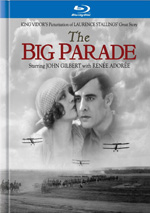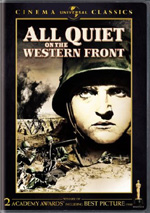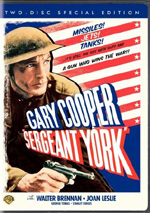|
TURNER HOME ENTERTAINMENT
|

| |
|
MOVIE INFO
|
|
Director:
King Vidor
Cast:
John Gilbert, Renee Adoree, Hobart Bosworth.
Writing Credits:
Laurence Stallings (story), Harry Behn (scenario)
Synopsis:
The highest-grossing silent film of all time, as well as the first realistic war drama, tells the harrowing story of a young man's (John Gilbert) front-line experiences in World War I.
MPAA:
Not Rated
| |
|
DISC DETAILS
|
Presentation:
Aspect Ratio: 1.37:1
Audio:
English DTS-HD MA Stereo
Subtitles:
English
Latin Spanish
French
Castillian Spanish
Closed-captioned
Supplements Subtitles:
None
Runtime: 151 min.
Price: $27.98
Release Date: 10/1/2013
Bonus:
• Audio Commentary with Historian Jeffrey Vance
• ď1925 Studio TourĒ Featurette
• Trailer
• 64-Page Book
| |
|
PURCHASE @ AMAZON.COM
|

| |
|
EQUIPMENT
|
Panasonic TC-P60VT60 60-Inch 1080p 600Hz 3D Smart Plasma HDTV; Sony STR-DG1200 7.1 Channel Receiver; Panasonic DMP-BD60K Blu-Ray Player using HDMI outputs; Michael Green Revolution Cinema 6i Speakers (all five); Kenwood 1050SW 150-watt Subwoofer.
| |
|
RELATED REVIEWS
|


| |
[an error occurred while processing this directive]
|
The Big Parade [Blu-Ray Book] (1925)
|
|
Reviewed by Colin Jacobson (March 6, 2014)
For an epic from the silent days, we go to 1925ís The Big Parade. Set in 1917, we view the United States right before the nationís entry into World War I.
The son of a wealthy mill owner (Hobart Bosworth), Jim Apperson (John Gilbert) lives a life of pampered ease. When the US joins the war, however, this changes Ė though not immediately. Initially Jim resists the call to duty, but encouraged by the passion of his lifelong love Justyn Reed (Claire Adams), he enlists.
From there we follow Jim through training, where he befriends working class stiffs Slim (Karl Dane) and Bull (Tom OíBrien). Before long, they get deployed to France, where they reside in a farmhouse and initially find themselves stuck with menial tasks.
With time on his hands, Jim finds himself attracted to Melisande (Renťe Adorťe), the daughter of the farmís owner. They develop a gradual courtship with complications due to language and Jimís prior relationship with Justyn. They attempt to overcome the odds only to be separated when Jim gets sent to the front. We follow his battle career as well as further developments with Melisande.
Going into Parade, I didnít know what to expect. Would it provide an action melodrama ala Wings or an anti-war effort like All Quiet on the Western Front?
As it happens, Parade touches on both genres, though it emphasizes the former. Much of the film concentrates on ordinary life and Jim/Melisande, with slow pacing along the way. Indeed, to paraphrase a Dr. Ian Malcolm, I occasionally wondered if they eventually planned to have war in their war movie.
Those elements arose roughly midway into the film and they dominated the second half, but donít expect anything as gritty as All Quiet - or as thrilling as Wings. Parade tends to play it down the middle, as it provides some dramatic moments but never quite enters the realm of harrowing or disturbing.
Part of the problem comes from its excessive comic relief, especially as embodied by Bull and Slim. Those two characters come with such broad portrayals that it becomes tough to ever take them seriously. Even when peril and drama surround them, we donít quite invest in their fates because theyíre so cartoony.
Thatís a problem, especially because the leads offer surprisingly strong work. Gilbert and Adorťe occasionally go for the broad strokes typical of the silent era, but they usually give their roles a fairly natural feel, and that allows us to take to them more easily. Without wide-eyed hamminess, we grow to care about Jim and Melisande and relate to them better than we might.
It really does seem difficult to gauge Paradeís leanings, though. Parts of it feel like feel-good heroic fare while others come across as more bitter anti-war tones. Perhaps I should embrace the absence of a clear stance, but instead, I think the film seems wishy-washy, like it canít decide which way to go. This doesnít cripple the movie, but it creates some issues.
Though even with a more consistent tone, I donít know how much Iíd like Parade. At best, itís a pretty good little war-related melodrama, and even with its slow pace, it remains reasonably entertaining. However, I think later movies handled the subject matter better, so it winds up as an inconsistent pleasure.
|
The Disc Grades: Picture A-/ Audio B/ Bonus B-
|
|
The Big Parade appears in an aspect ratio of approximately 1.37:1 on this Blu-Ray Disc. Given the age of the film, the image looked splendid.
Sharpness had uneven elements and could be slightly soft at times. Nonetheless, overall definition was quite good, as even the occasional instances in which the movie was a bit fuzzy didnít cause real distractions. Clarity held up nicely during most of the flick, as even the wide shots looked pretty accurate and concise.
I noticed no signs of jaggies or moirť effects, and edge haloes were absent. The film lacked print flaws and came with natural grain, so I didnít suspect any heavy-handed noise reduction. Like many silent films, Parade mixed black and white with color, but just one color at a time. These tones stayed subdued and seemed adequate for what they intended to represent.
Blacks appeared reasonably tight and dense, and low-light shots were pretty clear. Some opacity came with the latter, but not to a substantial degree, so the shadows remained concise and viewable. I felt impressed by the filmís restoration, as it made a nearly 90-year-old work look very good.
In terms of audio, the film came with a DTS-HD MA Stereo score recorded in 1988. It presented a perfectly appropriate accompaniment to the film. Stereo imaging was fine, as the work spread across the front in a pleasing manner.
The music came across as full and vivid as well. Highs seemed bright and tight, while lows were rich and dynamic. The score worked fine for the movie and sounded good.
When we move to extras, we find an audio commentary from historian Jeffrey Vance. In addition to his running, screen-specific discussion, we get four segments from an oral history director King Vidor recorded for the Directorís Guild of America. Between Vance and Vidor, we learn about the movieís roots and development, World War I history, story, characters and performances, sets and locations, various effects, biographies for cast and crew, music, and some other areas.
Overall, the commentary works well. The addition of Vidorís notes helps keep the track going; while Vance does fine, he occasionally threatens to sag, so the ability to give him a break allows the chat to remain productive. We get a nice mix of details about the production in this informative piece.
In addition to the filmís trailer, we get a featurette. 1925 Studio Tour runs 31 minutes, 59 seconds as it provides a silent look at the MGM lot. The program lets us see the physical plant as well as many actors, directors, executives and other workers. We donít view much actual filmmaking, but this remains a cool archival glimpse of Hollywood circa 1925.
The package finishes with a 64-page book. In this, we see photos, production notes, biographies and advertising elements. Packed with a lot of good material, this is one of the better books included in a Warner product.
Nearly 90 years after its release, The Big Parade gives us a good but not great war movie. While it boasts some interesting elements and strong performances from its leads, it lacks consistency and moves too slowly. The Blu-ray brings us excellent visuals as well as solid audio and some useful bonus materials. While I donít think this is a great flick, the Blu-ray impresses me.
|
|
[an error occurred while processing this directive]
|
|

